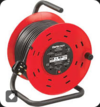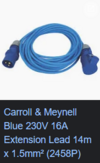1.5mm is fine, at the fuse rating of 13amps, for the extension and the fuse, is in the plug. If the cable is smaller, then the fuse in the plug should be less than 13 amps, to match the cable.
Where it goes wrong, is cheaply made multi-socket units, with fuses perhaps not meeting spec., and extension reels, where the user has ignored the instruction to unreel them before use, and the extension is being used at maximum current. Many wrongly think the issue is a problem of induction, because the cable is still coiled. In fact, it is simply the cable coiled up, being unable to get rid of the heat. All cable do get warm, when carrying current, how hot, depends upon how much current, and how close to their maximum rating they are run.
I'm away from home, on a caravan site, at the moment. Yesterday, there was a motorhome, plugged into the EHU, using their 2.5mm orange lead. All fine, apart from the owners had simply run off the reel, the cable they needed, and left the remainder still coiled up on the reel. Weather is OK at the moment, but had they been using that EHU at maximum capacity, to provide heat, and hot water etc., the risk was of that coiled cable overheating, melting, perhaps causing a fire.




